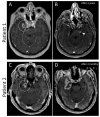Ectopic Recurrence of Skull Base Chordoma after Proton Therapy
- PMID: 35448165
- PMCID: PMC9026729
- DOI: 10.3390/curroncol29040191
Ectopic Recurrence of Skull Base Chordoma after Proton Therapy
Abstract
Background: Chordoma are rare tumors of the axial skeleton. The treatment gold standard is surgery, followed by particle radiotherapy. Total resection is usually not achievable in skull base chordoma (SBC) and high recurrence rates are reported. Ectopic recurrence as a first sign of treatment failure is considered rare. Favorable sites of these ectopic recurrences remain unknown.
Methods: Five out of 16 SBC patients treated with proton therapy and surgical resection developed ectopic recurrence as a first sign of treatment failure were critically analyzed regarding prior surgery, radiotherapy, and recurrences at follow-up imaging.
Results: Eighteen recurrences were defined in five patients. A total of 31 surgeries were performed for primary tumors and recurrences. Seventeen out of eighteen (94%) ectopic recurrences could be related to prior surgical tracts, outside the therapeutic radiation dose. Follow-up imaging showed that tumor recurrence was difficult to distinguish from radiation necrosis and anatomical changes due to surgery.
Conclusions: In our cohort, we found uncommon ectopic recurrences in the surgical tract. Our theory is that these recurrences are due to microscopic tumor spill during surgery. These cells did not receive a therapeutic radiation dose. Advances in surgical possibilities and adjusted radiotherapy target volumes might improve local control and survival.
Keywords: chordoma; proton therapy; recurrence; skull base; surgery.
Conflict of interest statement
The authors declare no conflict of interest.
Figures




References
-
- Bakker S.H., Jacobs W.C.H., Pondaag W., Gelderblom H., Nout R.A., Dijkstra P.D.S., Peul W.C., Vleggeert-Lankamp C.L.A. Chordoma: A systematic review of the epidemiology and clinical prognostic factors predicting progression-free and overall survival. Eur. Spine J. 2018;27:3043–3058. doi: 10.1007/s00586-018-5764-0. - DOI - PubMed
MeSH terms
Associated data
LinkOut - more resources
Full Text Sources
Medical

